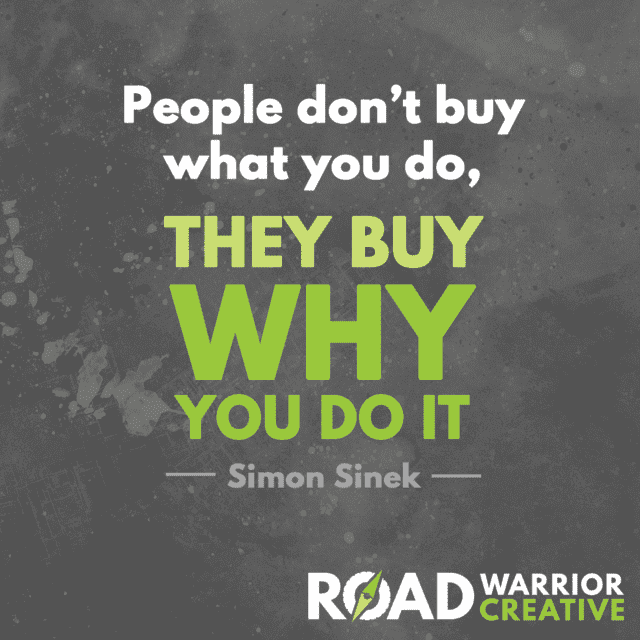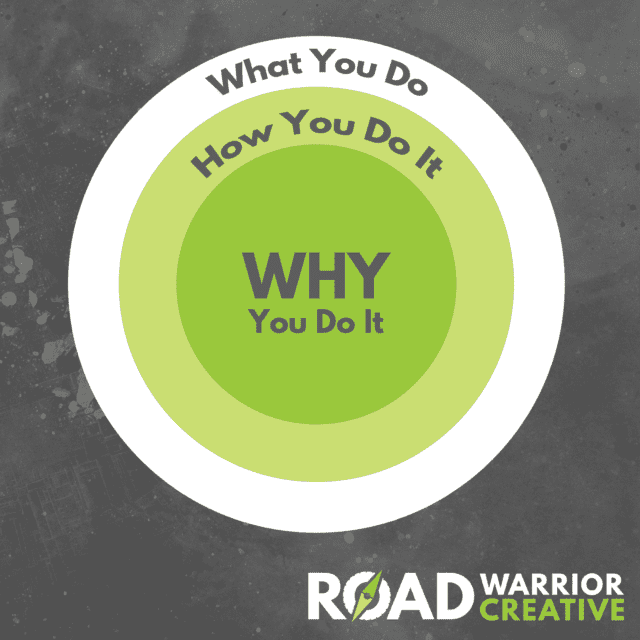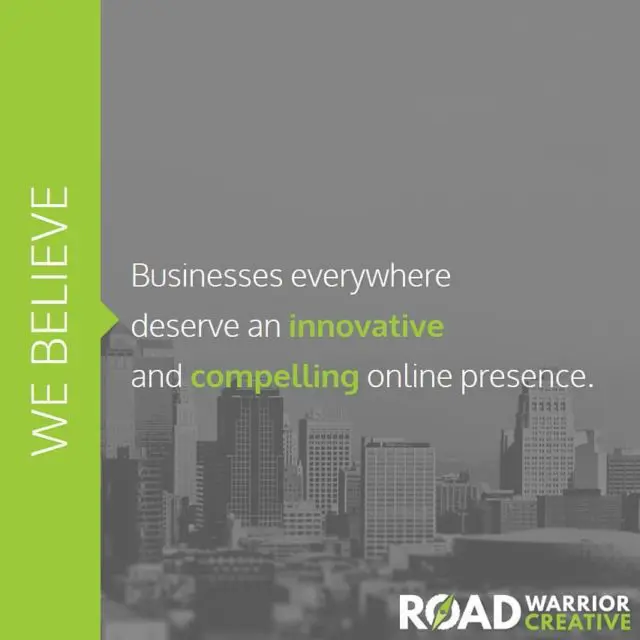As Chris and I started working on our rebrand, the first thing we focused on was creating a purpose statement for Road Warrior Creative. Over the past five years, we have figured out what we do and how we do it – our recent rebrand gave us the opportunity to refine both our services and our offerings further, but before we could work on the what and how of our business, we first needed to establish the “why” behind it all.

There is a great book titled Start With Why: How Great Leaders Inspire Everyone to Take Action, which uses a neuroscience perspective to explain why we do what we do and how we make decisions. The book, written by Simon Sinek, describes the emotional core of our decision-making and the fact that there is a singular purpose, cause, or belief that drives everything we do. Sinek talks about the “why” both from a personal perspective and also a business perspective. His examples focus on organizational purpose statements that resonate with employees and customers; he envisions a world where employees are excited to go to work and customers are loyal to businesses without a second thought. Creating this organization is possible, he says, with the establishment of a compelling purpose statement.
Before I get into the details of how we created our business purpose statement, I’m going to start by telling you what we did wrong. There are many, many small businesses out there operating just as we were, many of whom were started in the same gradual manner as how I started Au Coeur Design. I hope that by sharing where we were and how we got to where we are now, other businesses will also be inspired to discover their WHY.
Starting A Business Without A Purpose Statement
I very much “fell into” the creation of Au Coeur Design. In the spring of 2010, I modified a WordPress theme for myself to use on my blog. We had just moved to Nantucket, and I wanted to start blogging about our experience 30 miles out to sea and my new life as a (mostly) stay-at-home mom.
When I couldn’t find a theme that I liked out of the box for my WordPress site, I started playing around with modifying one – making small HTML and CSS changes. In the process, I discovered that I enjoyed learning and manipulating WordPress, and I began teaching myself more PHP and JavaScript to make even bigger changes. Not long after, one of my friends asked for help with her blog; soon, I was helping a handful of friends and acquaintances perfect their blogs and websites. By the end of 2010, I realized that this nerdy hobby of mine could be more than just fun – it could also help to pay the bills, and Au Coeur Design was born as a freelancing business.
Because Au Coeur Design came into existence gradually, first as a hobby, then as a solo freelancing operation – before I even realized that I was starting a business – there was never any intentionality to many parts of the business. Even as we grew into a small agency with a team beyond just me, many aspects of who we were and what we offered came into being without the justification of a strong purpose statement.
As my business grew, I realized that its lack of a clearly defined purpose was holding it back.
Click to tweet
Having a purpose statement would have grounded us and provided guidelines as services, procedures, and policies were created. It would have helped to drive our corporate identity and provide direction in organizational decision-making.
Without a purpose statement, we found ourselves offering more services than just those where we truly excelled and could make a strong impact on our clients’ bottom lines. At times we were making business decisions seemingly willy-nilly without an underlying foundation of purpose.
Starting A Business With Intentionality
After reading Start With Why and realizing the current status of my business, it became clear over the course of last spring and early summer that a rebrand was necessary for future success. Because we already had a basic idea of the what and how of our new business, the first thing Chris and I did – before we thought up a name or started paring down services – was work to create a purpose statement.
A purpose statement is different from a business’ mission, vision, and values statements.
A business’ mission statement explains what a business does and who it does it for. Vision statements layout long term goals for the business’ success and future, while values statements explain what is important to the business and help to define its culture. Before any of these statements can be drafted, the founders of an organization must first establish its purpose or the reason why it exists in the first place. Purpose statements are motivational statements that speak to the heart of the organization and are central to everything it does. They are the “philosophical heartbeat” of a company, says an article in the Harvard Business Review.
Mission, vision, and values statements may be adjusted over time as companies grow, change, and move into new markets, but the “why” behind the organization – why it was created in the first place and why it exists will never change. Each time executives are considering adding new products or services when marketing materials are created, or new markets are explored, a purpose statement is something that can be revisited to help with the decision-making process. Successful businesses are businesses that adhere to a clearly defined purpose in all that they do.
Writing A Purpose Statement Starts With Research
Knowing the importance of the business purpose, we spent weeks discussing, writing and rewriting our statement. Our first step was research: in addition to re-reading Sinek’s book, I also spent time reading as many articles online as I could find about how to write a good purpose statement.
After reading “how to” articles, we turned to finding and analyzing the purpose statements of other businesses. I created a document that listed other companies’ statements so that we could see them side-by-side. We tried to identify purpose statements on the websites of our competitors – businesses that offer the same services that we do – and also on the websites of major corporations or successful small businesses in industries completely different from ours.
Spending time looking at other people’s statements helped us to determine what worked and what didn’t. We found that many businesses in our industry do not have a clearly defined purpose. For businesses with purpose statements, it became clear that certain types of words and phrases resonated stronger than others. Two purpose statements that I kept coming back to were those of Nike:
To bring inspiration and innovation to every athlete* in the world. (*If you have a body, you are an athlete.)
and Starbucks:
To inspire and nurture the human spirit – one person, one cup and one neighborhood at a time.
Both of these statements resonated with me because of the words used (“inspiration/inspire,” “innovation,” and “nurture the human spirit,” for example), but also because they are excellent examples of Sinek’s Golden Circle of Marketing.
The Golden Circle Of Marketing
There are three layers of how you can market your business:
- you can talk about WHAT your business does,
- you can talk about HOW your does what it does,
- or you can talking about WHY your business does what it does.

Sinek calls this the “Golden Circle of Marketing” with the “what” on the outside of the circle, moving to the “why” as the inner circle. A business’ “what” and “how” messages speak to their customer’s rational brain. They explain the services offered and how they are offered, typically in a way that attempts to make that business stand apart from its competitors. The “why” statement targets the emotional center of our brains, which neurosience has shown us is how we make decisions. For this reason, Sinek says, “The best marketing messages don’t say what we do or even how we do it, but why we do it.” Click to tweet
Starbucks’ and Nike’s mission statements (really purpose statements) and great examples of why statements. Take Starbucks, for example:
Our mission: to inspire and nurture the human spirit – one person, one cup and one neighborhood at a time.
What they do is sell coffee. How they do it is in neighborhood shops with free wifi and employees who get better benefits than those in many similar businesses. But the WHY behind it all is that they want “to inspire and nurture the human spirit.” If you had to choose between getting coffee at a place whose message is “we sell great coffee” or a place whose message is “we want to inspire and nurture the human spirit, and that is the driving force behind everything we do, which just happens to include selling great coffee,” which would you choose?
How To Write A Business Purpose Statement
When Chris and I set out to write the purpose statement for our business, we started with a list of questions that we had to answer:
- What do we do?
- For whom do we do it?
- Why do we serve our clients in the way that we do?
- Why are we in this industry?
- Why did we start this business?
- What image of our business do we want to convey?
Until we knew the answers to these questions, we couldn’t move forward with writing our purpose statement, so we first started by answering these questions. Individually, Chris and I wrote the answers to these questions as we understood them, then we came together to discuss our individual thoughts and to find common ground. When we came together, we immediately agreed that there was a dual purpose behind our business: why we were rebranding for us and why we were rebranding for our clients. We knew we needed a purpose that spoke to our desires, our team’s desires, and to our client’s desires all at once.
As we were discussing the future, the thing we kept returning to is that we started our own business because we are both driven to be independent and innovative in a way that is not possible if we were working as employees for someone else. This, along with our shared passion for adventure, led us to the Road Warrior Creative concept: building a business around a commitment to travel and spending time on the road meeting clients face-to-face. Both Chris and I loved this idea because it fulfills our desire for what our life’s work will do for us as individuals, as a family and because we know that it will provide real value to our clients.
Once we had established the foundation, we started brainstorming and creating lists of words from which a sentence could be formed. We had three lists:
- Nouns: touching on more of our “what” – this list included words like website/websites, brand/branding, online presence, digital solutions, etc.
- Verbs: action words that convey the feeling of our organization’s goals for clients – this included a lot of the words that are seen throughout our website, many of which fit our “road warrior” theme, I.e. drive, accelerate, rev up, etc.
- Inspiring words: those that touch people’s emotional core, such as empower, deserve, inspiration, innovation.
The hardest part was putting it all together into a cohesive and concise statement that explain who we are at our core and why we do what we do. As we further discussed our commitment to travel, another thought we kept returning to is that there are many businesses in geographic areas with few online marketing agencies or there may be agencies in their area that are not the right fit for one reason or another. Additionally Chris and I both have a strong commitment to working with startups and small businesses. We want businesses, whether they are located in New York City or in a small town near the Rockies, whether they have 10 employees or 100, to have the same growth ability online. As we talked through our goals, interests, and beliefs over a few days, our purpose statement began to take shape from the lists of words we had drawn up. After focus grouping it a bit, we made some minor adjustments and excitedly published our official purpose:

Next Steps
From the creation of this statement, we were able to finish fully redefining who we are with our manifesto and in the reworking of our services and brand identity. It took many hours of hard work to discover our “why” statement, but we’ll be able to have it to reference as we move forward with our new brand and work to do better than our mistakes of the past.
If you haven’t taken the time to sit down and figure out your business’ why statement, I highly recommend you do so. Having a clear purpose and focus for everything your business does is key to shifting from business to brand. From how you speak to customers to the connection your employees feel within the organization to the decisions that are made along the way, an engaging purpose statement will bring it all together and ensure your business’ success.
What’s your business’ purpose? Leave me a comment and let me know.

Leave a Reply